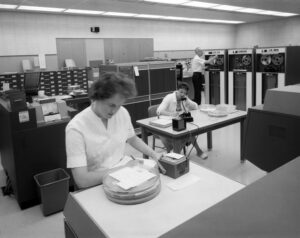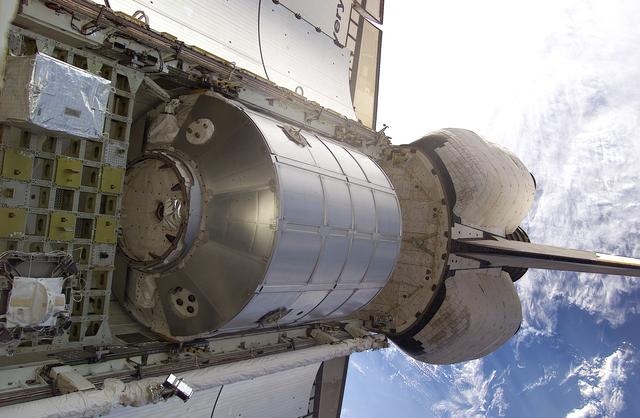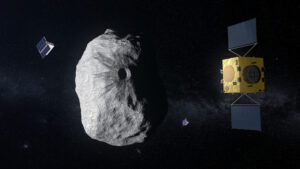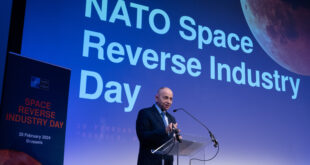By Christophe Bosquillon
Part 1 of a review of Space Resources Week 2022 is already available in a previous edition as a descriptive review. The below Part 2 includes the author’s more personal views on several space resource utilization topics in the context of SRW.
Wasn’t the grandmother of all space resources first and foremost… data?

Copyright: NASA 1963
Although fascinated by whatever humanity sent to Earth orbit, the Moon, and across the Solar System (and having seriously worked on Outer Space Treaty implications only recently), we believe that space resources utilization started with data: from natural resources to foreign direct investment in the manufacturing sector in dire need of tracking supply chains half-way around the world, to pro bono activities in earthquakes and tsunamis relief, we could use much more Earth Observation, localization, and tracking data. That is even more the case in disaster relief, where we are often still flying blind. So, there is significant room for improvement worldwide, requiring better infrastructure and connectivity. Having resided the best part of the past decades in the Indo-Pacific, we’d say that applies to Europe as well, due to unequal connectivity between the west and the rest. And in Asia like over our European shores, data from orbit can inform us on major issues from the Blue Economy to on-going climate and environmental crises to defense and security matters.
Opportunities beyond Earth-related data: space transportation logistics first
Beyond data, there are certainly opportunities to develop stronger dual tech value chains with governments as robustly invested anchor customers, motivating private sector investments. In the late 90’s, while researching orbital and re-entry techno-economics in the context of Asia and Middle-East ballistic proliferation, we serendipitously bumped into the first generation of ‘new space’ people and tentative entrepreneurs: we became aware of the concept of Reusable Launch Vehicles (RLVs), with an aim to reduce the cost of access to space by 1 then 2 orders of magnitude. Fast forward to today, Elon is in the process of achieving this with >100 mt Starship showing cost reductions of 93-96% vs competitors, depending on configurations. However, back in the late 90’s-early 00’s, the NASA relationship pattern with the private sector and its contracting models hadn’t evolved yet to enable RLVs to happen. There were a lot of failed attempts before the Elon’s era, thus timing is essential in the innovation business.

Regardless, RLV concepts were not properly acknowledged in Europe even into the 2010’s, perhaps in part due to an understandable concern it would cannibalize legacy expandable launchers markets. Next, we suddenly had to unhitch from our relationship with Russia. So, it’s an existential issue of access to space for Europe, but also, of competitive logistics for markets in orbit and beyond. Unless we Europeans master logistics of >100 mt carriers (with ratio of cargo to propellant of 1 to 12-15, over 90% capacity is taken by propellant) we may remain confined to payload capacities between a few kgs and ‘several’ tons at best. At that rate, we Europeans will remain dependent on Elon et al. >100 mt capacities for build-up in orbit, on Moon, and beyond. For now, Europe does micro-launchers, it’s a good start. However, we should be on par with the US in >100 mt capacities, otherwise, no real ‘strategic autonomy’.
When you’re in the resources market with a substantial mining and shipping component between the economically exploitable reserve and downstream markets from wholesale to transformer to retailer to consumers, you operate with ‘cost + freight’: space ‘freight’ is disproportionate. And while reading with some excitement all the literature on the Moon and Mars, and gems like ‘A Rain of Iron and Glass’, we couldn’t help thinking that this didn’t make any economic sense whatsoever, in addition to ignoring most elementary mining and logistics rules. Or, at least, one would exploit a space resource in space, rather than add to the transportation cost pain in order to bring that refined resource back on Earth markets. And even if one talks about high-value components that might still be economically viable back on Earth markets, good luck with building that factory in orbit or near or on the Moon.
So, when we resumed working on these issues in the late 2010’s, we were still ‘perplexed’ on how logistically and economically viable, and bankable, upcoming projects would prove.
Enters Space Resources Week.
Appreciating Space Resources Week’s relevance from a terrestrial mining perspective

Canada is a major terrestrial mining power, and that is primarily through its province of Saskatchewan. A decade ago, Saskatchewan published its 2012 guidelines for mining supply chain actors focused on two essential industries, potash and uranium (we came across it being commercially involved in the former, while aware of the latter). The point is that a mining firm does mostly three things: managing cash flow, dealing with legal and regulatory affairs, and cultivating technical ‘secret sauces’. Everything else is being performed by contractors as part of well-structured value chains. Including the initial step of mapping and assessing a precisely quantified and economically extractable ‘reserve’ out of a broadly localized ‘resource’- that part often conducted by a speculative mining venture, whose exit strategy for investors, if successful, includes being flipped to a mining major. The pre-Lehman Shock bubble in natural resources in 2007-08 is edifying in relation with that speculative mining pathway: Russians and Belorussians producers cornered the potash market, prices went up 400% (from roughly USD 200/mt to 1,000/mt) and the market literally had to stop buying for a while until the bubble burst and prices went back to “normal”. In the meantime, a flurry of amateur investors got burned in new potash mining ventures, having no idea of the value chains, economic sustainability, and due process to ascertain a speculative mining ‘reserve’.
At the time, we attempted to pass these points across to new space friends: to mine whatever we find on asteroids (the Moon did come back in the conversation after discovery of water at the south pole), rather than a holistic mining company, we might as well identify value chain participants (contractors), and develop them independently. We also need a due process in how we ascertain precisely quantified ‘reserves’ out of a potential ‘resource’. Fast forward to early 2021, we resumed independent working group research on mining and ISRU value chains for the Moon, dusting off the 2012 Saskatchewan mining supply-chain management methodology. In Spring 2021 we took the Space Resources Utilization course developed by the legendary trio of Colorado School of Mines, International Space University, and Luxembourg Space Agency, in the process attending online the SRW 2021 3rd edition: you can imagine our sense of reckoning when one of the presentations, titled ‘So you want to be a space miner’ had one of its slides on mining value chains and full economic reasoning borrowed from the 2012 Saskatchewan guidance! Another memorable presentation was the LORS framework developed by the Luxembourg branch of iSpace (Japan), offering a terrestrial mining and oil & gas exploration industry inspired framework, to map out the full cycle from assumed resources to quantified extractable reserves for the Moon and beyond.
A mining firm does mostly three things: managing cash flow, dealing with legal and regulatory affairs, and cultivating technical ‘secret sauces’.
There were many great features at SRW 2021, but the above is one of the strong reasons why we came back for more in 2022- the scheduling choice was made harder due to the Lausanne Space Debris conference taking place at the same time. Nonetheless, we stuck to our SRU guns – by the way, recyclable debris fit in SRU too – in our relentless pursuits of developing business cases in and beyond orbit: value propositions that are TRL-realistic over time, commercially credible, financially sustainable, legally implementable. But in order for a venture to be able to survive and thrive, in addition to a realistic assessment of value chains and real ‘paying’ customers, it needs to build a foundation on Earth, so to sustain its foray into markets in or beyond orbit (cislunar, Moon, asteroids, Mars…). That is perfectly implemented by companies such as OffWorld (mining robots) or Manna (solar panels from silica extracted from terrestrial sand and lunar/Martian regolith). To our delight, iSpace from Japan in Luxembourg was back, to elaborate on mining-resource-to-reserves due process, this time around with a cautionary tale on notorious terrestrial mining scams (the infamous Bre-X gold scandal of the late 1990’s) and how to prevent these from ever happening on the Moon. Having lived in the Indo-Pacific for the best part of the previous decades, we remember the story of the fake gold deposit at Busang, East Kalimantan, in Indonesia, like it was yesterday: spiced up gold samples, geologists falling from a chopper, etc. It does strike us as realistic to ensure that measures from proper licensing to rigorous assessments are being implemented. Otherwise human nature warrants that the same could happen in the Shackleton crater.
Entanglements have consequences, autonomy still requires international cooperation
Whether for supplying resources and commodities essential to life, or for supplying chains of facilities, components, or consumers goods, entanglements do have consequences. Unhitching from toxic relationships with hostile nation states in a geopolitical context does brutally impact the raison d’être of our international cooperation, and space is no stranger to that problem, as experienced currently. But even vis-à-vis friends and allies need autonomy. Thus, in the context of analogues for Earth-sourced regolith simulants, an ESA/UK initiative to secure a European autonomous simulant supply makes perfect sense.
Evolving space law and governance toward a reality that remains to be discovered
Nonetheless, our communities keep trying to develop national and international frameworks of space law and adaptive governance to maintain peace and sustainability in outer space. All that coming from the great legacy of the Outer Space Treaty, its body of related Conventions, and a number of governance efforts over time. Yet a harsh techno-economic reality requires proof of concept and ability to turn vision into actual business to be demonstrated, as asserted by RedWire Space.
In the context of analogues for Earth-sourced regolith simulants, an ESA/UK initiative to secure a European autonomous simulant supply makes perfect sense.
The issue here is that the reality we are trying to regulate relates to space developments that remain to be implemented; frameworks requiring evolution and operationalization in context of practical implementations that have yet to happen during the rest of this century; and that won’t scale up until the private sector outgrows a model of government as sole (paying) anchor customer. And unless privateers can demonstrate a clear mapping of the demand side and can operate on solid ground to finance not only equity but also debt with functional credit and collaterals, supply side hype and cyclical tech bubbles may only drive real SRU so far.
Transportation, security, data, better funding models, and a global presence for Space Resources Week?
We see SRW as successfully evolving into a one full-week event, in more locations globally. Orbital and cislunar transportation, Gateway-Mars logistics, are opportune topics to develop, they make or break the value chains economics for a sustainable space resources utilization. Peaceful security matters, from protecting our orbital assets to making sure our cislunar and lunar assets for space resources utilization, are in a position to deter harmful interference (resilience is not enough, a full deterrence doctrine is required). Data has a value chain of its own in all aspects of space resources economics and governance (including human physio-psychological health data- implications for space labour laws). Data could use decentralized collaborative platforms equitably sharing value and benefits among contributors. There’s a need to clarify and quantify value chains for debt/equity investors, to develop SRU relevant PPPs, debt/equity financing, risk management, and insurance/reinsurance models. And we could all benefit from integration between space domain actors and non-space industries.

Currently based in Europe, Christophe Bosquillon operated globally out of the Indo-Pacific for the best part of the past decades. With a techno-economic background in non-space industries, as well as international affairs and foreign direct investment, Chris maintains a long-standing interest in old and new space, also from a security and policy standpoint. A decade ago, he developed a ‘Legal Hacker’ interest in the digital transformation governance field, data rights, computational law, and composable governance. Founder of Autonomous Space Futures Ltd., Chris, an experienced corporate boss and business owner, focuses on solutions to develop business cases in and beyond orbit: value propositions TRL-realistic over time, commercially credible, financially sustainable, legally implementable ; optimizing open data and registration in a context of adaptive governance for peaceful and sustainable space activities. While fixing the investee-investors relationship, value creation, and funding processes, Chris currently works out on the steep learning curve of space law, governance, and diplomacy, with the help of diverse friends from all over our precious blue planet.
With several masters but “too busy for a PhD”, Chris did evolve, lately: being surrounded by doctors and candidates with collaborative pursuits in digital and space law, governance, and policy, does help to collectively re-imagine a future as responsible stakeholders, and design sustainability solutions. Chris likes to bring down siloed mentalities and bridge practitioners and academia, across transdisciplinary teams that produce useful, usable, and used outputs.





